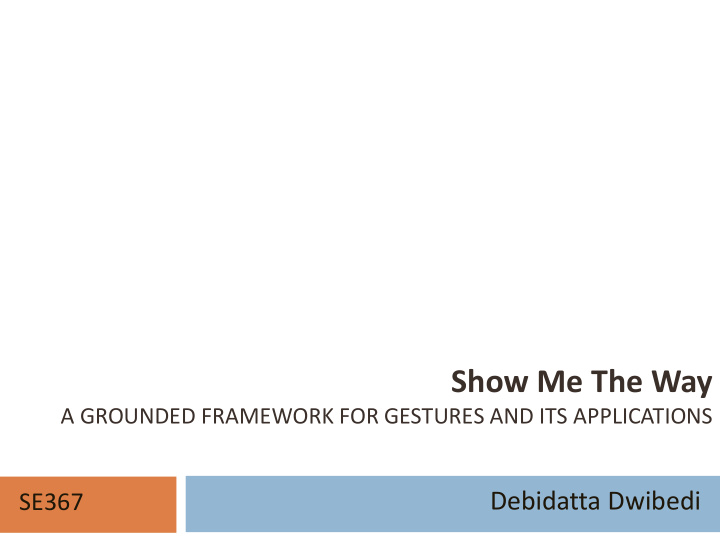



Show Me The Way A GROUNDED FRAMEWORK FOR GESTURES AND ITS APPLICATIONS Debidatta Dwibedi SE367
Objective A framework that is able to: Learn gestures Take descriptions while performing gestures as input Associate gestures with words Use this framework to: generate gestures helpful in route descriptions using an embodied cognition agent (ECA) i.e. a robot or a simulation of one.
Applications Robot giving directions in a shopping mall
Related Work Knowledge representation for generating locating gestures in route directions [Striegnitz et al] Integrated model of speech and gesture in robots [Kopp et al] Studied models of utterance, gesture and timing to better facilitate the human-robot interaction [Okuno et al] A joint model of language and perception for grounded Kopp et al attribute learning [Matuszek et al]
Recording Gestures Used a Kinect to record gestures Easy to get coordinates of joints and hands Egocentric coordinates by subtracting hip coordinates Used Frechet distance to compare query gesture with recorded gestures One shot learning of gestures. No training dataset or programming required Humans can teach gestures without programming
Extracting words and phrases from route/assembly descriptions Collected route descriptions to discover words and phrases that might need gestural representation 37 route descriptions collected Words and phrases discovered: right, left , turn, straight, hall, road, walk, building ('take', 'right'), ('take', 'left'), ('go', 'straight'), ('turn', 'left'),('turn', 'right'), ('right', 'turn') Collected assembly instructions of a TV stand Words and phrases discovered: shelf, frame, glass, place, top, bottom, bolts ('allen', 'wrench'), ('shelf', 'frame'), ('bottom', 'shelf') , ('glass', 'shelf'), ('top', 'shelf')
Associating Words with Gestures Conditional probability to find most probable word associated with that gesture Maximise ratio of P(Gesture|Word) to P(All other gestures|Word)
Transferring Gestures to ECA Using Choreographe to simulate gestures Nao robot is the chosen ECA http://youtu.be/VKo1L9OzB2c Easily transfer these gestures to a robot Cannot orient body in direction of turn Map coordinates from the recorded gesture to joint angles of the robot “Take Right”
References Tversky, Barbara, et al. "Explanations in gesture, diagram, and word." Spatial Language and Dialogue, Coventry, KR, Tenbrink, T., and Bateman, J.(Eds.), Oxford University Press, Oxford (2009). Kopp, Stefan, Kirsten Bergmann, and Ipke Wachsmuth. "Multimodal communication from multimodal thinking — towards an integrated model of speech and gesture production." International Journal of Semantic Computing 2.01 (2008): 115-136. Okuno, Yusuke, et al. "Providing route directions: design of robot's utterance, gesture, and timing." Human-Robot Interaction (HRI), 2009 4th ACM/IEEE International Conference on. IEEE, 2009. Striegnitz, Kristina, et al. "Knowledge representation for generating locating gestures in route directions." Proceedings of Workshop on Spatial Language and Dialogue (5th Workshop on Language and Space). 2005. Matuszek, Cynthia, et al. "A Joint Model of Language and Perception for Grounded Attribute Learning." arXiv preprint arXiv:1206.6423 (2012).
Recommend
More recommend